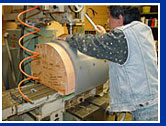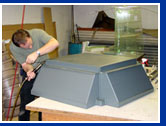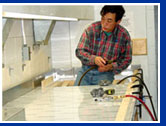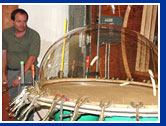|
As there are many different plastic processes
available, we hope this information will assist you in determining
what plastic process may be the best one to produce the part that
you may want. Contact our
technical sales personnel to discuss the processes further
and which process and which material is best suited for your specific
application.
Fabrication
 The
fabricators at Kren Plastics are among the most skilled and trained
in the industry - what the master carpenter
does with wood, we do with plastic. We have the tools and equipment
to create almost anything
you can imagine. Such things aquariums, display cases for art
galleries and museums, retail displays, restaurant fixtures, furniture,
skylights, as well as a wide variety of components for industrial,
electronic, computer and medical equipment. The
fabricators at Kren Plastics are among the most skilled and trained
in the industry - what the master carpenter
does with wood, we do with plastic. We have the tools and equipment
to create almost anything
you can imagine. Such things aquariums, display cases for art
galleries and museums, retail displays, restaurant fixtures, furniture,
skylights, as well as a wide variety of components for industrial,
electronic, computer and medical equipment.
Our fabricators utilize every possible technique
available in the fabrication of plastics, including heat strip
bending, cutting, solvent cementing, polymer cementing, sandblasting,
flame polishing, buff polishing, hot air welding, thermoforming,
drape forming and free blow molding. In addition, we offer
die-cutting, screen-printing, hot stamping right through to the
final assembly and installation.
Utilizing the best techniques and equipment, we
can fabricate and machine any thermoplastic material available
including acrylic, polycarbonate, ABS, PVC, polystyrene, polyethylene,
polypropylene, UHMW and nylon.
 The
fabricators work closely with our sales personnel and customers
to ensure everything they build looks and works exactly as required. The
fabricators work closely with our sales personnel and customers
to ensure everything they build looks and works exactly as required.
Having the highest skilled fabricators in the industry,
combined with the best materials, techniques, tools and equipment.
we will build you a part that will meet and exceed your expectations
the first time around. Bring us a sample, a photo, a drawing,
a sketch or just an idea and we will discuss with you the best
way to proceed. TOP
 Pattern
Making Pattern
Making
Kren Plastics has extensive in-house tool,
jig and pattern making capabilities. For the majority of parts
we manufacture for our customers we
manufacture the tooling right in house. This allows us to have
complete control over our quality and production schedule.
We greatly reduce delivery time and costs ensuring
our customers receive their products in a timely and economical
manner. We utilize a wide variety of methods and materials to
build production jigs and tools, depending on the desired quality,
quantity and material of the finished product. A plywood and aborite
mold will be fabricated for a one-off acrylic display piece or
a reinforced fiberglass mold will be hand laid up for vacuum/pressure
forming.
 We
also have the capability to use a customer supplied CAD file to
carve complex 3-dimensional shapes from a solid block of wood
or MDF (Medite). Using the electronic CAD file, we can either
shape a short run production tool or a plug to create a long lasting
fiberglass or aluminum mold. We
also have the capability to use a customer supplied CAD file to
carve complex 3-dimensional shapes from a solid block of wood
or MDF (Medite). Using the electronic CAD file, we can either
shape a short run production tool or a plug to create a long lasting
fiberglass or aluminum mold.
If you have a product you would like manufactured,
talk to our technical sales personnel to get suggestions for the
best process and material to pursue with. TOP
Free
Blow Forming
Free Blow Forming
is used to produce dome shaped parts that require extremely high
optical clarity. Some examples of this would be aircraft windows,
skylights, observation domes and covers for security cameras.TOP
Drape
Forming
Drape Forming is used to produce
parts with a simple curve. Some examples of this would be cones,
cylinders, sneeze guards, motorcycle fairing, automobile windows,
boat windshields, and aircraft light lens covers. It involves
draping a sheet of hot plastic over a mold of the desired shape
and allowing the plastic to cool and harden to take that shape.
TOP
Matched
Mold Forming
Matched Mold Forming is a similar
process to drape forming, however instead of draping a sheet of
hot plastic over a one- piece mold; the sheet of plastic is sandwiched
between matching halves of a two-part mold. It is used to produce
more complex shapes with finer details. TOP
Vacuum
Forming
Vacuum Forming is used to produce
complex three-dimensional shapes such as dashboards, instrument
consoles, door panels, machine guards, paint masks, and retail
displays. Vacuum forming is when a sheet of hot plastic is drawn
over a three dimensional mold. A seal is created around the edges
of the mold, and then a vacuum is used to remove the air from
between the mold and plastic. Once the air is removed, atmospheric
pressure forces the material to take the exact shape of the mold,
the piece of plastic is allowed to cool and then removed to be
trimmed to the final size. TOP
Pressure
Forming
Pressure Forming is a very similar process to vacuum
forming except that while one side of the part has vacuum applied
to it the other side is pressurized with high-pressure compressed
air. This forces the hot plastic to take on sharper contours and
finer details than one can produce with vacuum forming.
This process produces parts that match injection-molding
quality on one side (inside or outside) for a fraction of the
injection molding tooling cost. We use pressure forming to produce
parts for computer, electronic and medical equipment such as protective
housing and enclosures, monitor bezels, keyboard casing, etc.
Pressure Forming is
an ideal process to produce small to medium quantities anywhere
from fifty parts to several thousand parts per year. In addition,
it is an ideal process to produce parts for prototyping and test
marketing before going to the large mold expense of injection
molding.
Pressure forming molds are a lot easier, quicker
and more economical to modify if changes have to be made; however,
production cycle time of pressure formed parts is relatively longer
than injection molded parts. Therefore small to medium volumes,
particularly of larger parts, lend themselves to pressure forming,
while large volumes, particularly of small parts, tend to favor
injection molding. TOP
Injection
Molding
Injection Molding is a process suitable for high
volume production. It involves injecting molten plastic pellets
at high pressure and temperature into a closed mold. It produces
complex parts with fine details on both sides of the part, however
as the plastic needs to cool uniformly to prevent warpage the
wall thickness of the part has to remain relatively constant.
Because of the high temperature and pressures involved, molds
are typically machined out of blocks of hardened steel complete
with injection ports and thermocouplers.
Tooling for injection molding therefore tends to
be expensive and typically takes several weeks to produce. Modifications
to injection molds, if in fact they can be performed, are very
expensive and require time. Majority of the plastic components
in high volume consumer products that we see around us today:
telephones, televisions, computers, etc. are injection molded.
TOP
Rotational
Molding
Rotational Molding
is a process for producing hollow parts such as tanks, totes,
floats, buoys and bins. Plastic powder or pellets are loaded into
a closed mold then heated while being rotated about two axes.
The melting resin sticks to the hot inner surface of the mold,
layer upon layer, until all the resin is consumed and fused into
a solid-wall, hollow product. Molds are constructed from fabricated
sheet metal for less complex shapes.
For more complex shapes and to produce parts with
higher aesthetic value and precision assembly cast aluminum is
typically used. Features such as handles, threads, metal inserts,
custom colors, graphics, variable and adjustable wall thickness,
double-cavity or double-walled foam filled products are all common
with this process. TOP
|


